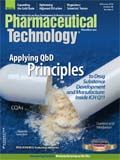News
Article
Pharmaceutical Technology
An Enhanced Approach to Drug-Substance Development and Manufacture
Author(s):
FDA and industry expert working group representatives discuss the pending ICH Q11 guideline.
The pending ICH Q11 guideline incorporates risk management and a science-based approach for the development and manufacture of drug substances.
ICH Q11, the pending guideline from the International Conference on Harmonization titled Development and Manufacture of Drug Substances, may be one of the most anticipated guidelines in the global pharmaceutical industry in recent years (1). Since 2004, the industry has been working to reshape its approach to drug manufacturing based on FDA's Pharmaceutical CGMPs for the 21st Century initiative, which were cemented between 2005 and 2008 by the so-called ICH Quality trio guidelines (2). These globally harmonized guidelines, which include ICH Q8 Pharmaceutical Development, Q9 Quality Risk Management, and Q10 Pharmaceutical Quality System, detailed quality-by-design (QbD) concepts for pharmaceutical manufacturing and redefined the industry lexicon with terms such as quality target product profile, critical quality attributes and critical process parameters (CQAs and CPPs), knowledge management, product life-cycle management, and control strategy (3–5). The Q11 guideline, which was published as a draft in May 2011 and is expected to be adopted by the ICH steering committee this year, both complements and enhances these concepts by offering industry guidance and clarity "regarding the description and justification of development and manufacturing processes for drug substances and the type and extent of information to be submitted in regulatory dossiers" (6).

IAN SANDERSON/PHOTOGRAPHER’S CHOICE RF/GETTY IMAGES
Q11 is one of the longest ICH quality guidelines at 26 pages and specifically addresses the drug-substance manufacturing process for chemical entities and biotechnological/biological entities.
Although the ICH Quality trio guidelines apply to drug substance as well as drug product, industry and regulators felt there was a need to clarify QbD or "enhanced" concepts for drug-substance manufacture. "There are fundamental scientific differences in the process for drug-substance manufacture and the process for drug-product manufacture, including impurity control and removal and chemical transformations," according to the Pharmaceutical Research and Manufacturers Association (PhRMA) representatives on the ICH Q11 expert working group. These representatives include: Betsy Fritschel, Johnson & Johnson and the PhRMA Topic Lead for ICH Q11; Timothy Watson, PhD, Pfizer; and Steven R. Mendivil, Amgen.
The ideas behind Q11
The quality of a drug product is linked to the quality of its drug substance. ICH Q11 therefore seeks to take into consideration and provide examples as appropriate for describing the principles and concepts which are included in ICH Q8, Q9, and Q10. ICH issued a concept paper for Q11 in April 2008 to identify these elements and to detail the goals of the proposed guideline. While defining differences between a "traditional" and an "enhanced" approach to drug-substance manufacture, Q11 states clearly that "Traditional and enhanced approaches are not mutually exclusive. A company can use either a traditional approach or an enhanced approach to drug substance development or a combination of both" (1). In the traditional approach, "set points and operating ranges for process parameters are defined and the drug substance control strategy is typically based on demonstration of process reproducibility and testing to meet established acceptance criteria" (1).
Q11 defines an enhanced approach for drug-substance manufacture as using risk management and extensive scientific knowledge to select process parameters and unit operations that impact CQAs "for evaluation in further studies to establish design space and control strategies applicable over the lifecycle of the drug substance" (1). The guideline provides illustrative examples and approaches for demonstrating product and process understanding that is gained during the process development of drug substances. It also outlines the information recommended for describing the manufacturing process and control strategy as well as considerations for selecting starting materials for synthetic and semisynthetic entities and source materials for biotechnological/biological entities and the related justification. In addition, Q11 addresses the elements and development of a control strategy; process validation and evaluation; and the regulatory evaluation process of drug-substance manufacturing, including the harmonization of common technical document (CTD) submissions (see sidebar on CTD submissions).

How to fill out the common technical document when using an enhanced approach
According to FDA members of the ICH Q11 working group, "identifying what is common and what is different between the development and manufacturing of chemical entities and biotechnological/biological drug substances was one of the key goals" in developing Q11 as well. These ICH Q11 working group members include: John Smith, PhD, CDER (ONDQA) and FDA Topic Lead; Patrick Swann, PhD, CDER (OBP), and FDA Deputy Topic Lead; Steve Wolfgang, PhD, CDER (OC), and Working Group Expert; Chris Joneckis, PhD, CBER, and Working Group Expert.
The details of Q11
The Q11 expert working group, which is made up of individuals from each of the six ICH parties (that is, the regulatory authorities and trade associations of the US, European Union, and Japan, plus numerous interested parties and observers), received more than 1300 comments during Step 3 (which is the regulatory consultation and discussion phase) of the ICH process and spent last fall working through them. Some of the comments were duplicates or very similar, according to the PhRMA Q11 expert working group members, and the highest percentage of the comments received requested clarification and revision of the guideline's process development section.
Q11 states that manufacturing process development should include, at a minimum, the following elements: identification of potential CQAs associated with the drug substance so that those characteristics having an impact on product quality can be studied and controlled; defining an appropriate manufacturing process; and defining a control strategy to ensure process performance and drug substance quality (1).
An enhanced approach to manufacturing process development would additionally include:
- A systematic approach to evaluating, understanding, and refining of the manufacturing process. This process includes identifying through prior knowledge, experimentation and risk assessment, the material attributes and process parameters that can have an effect on drug-substance CQAs. It further includes determining the functional relationships that link material attributes and process parameters to drug substance CQAs.
- Using the enhanced approach in combination with quality risk management to establish an appropriate control strategy (e.g., proposed design space(s) and/or real-time release testing) (1).
Q11 asserts that the increased knowledge and understanding obtained from taking an enhanced approach could facilitate continual improvement and innovation throughout the product lifecycle.
Defining CQAs. CQA is a physical, chemical, biological, or microbiological property or characteristic that should be within an appropriate limit, range, or distribution to ensure the desired product quality. Drug-substance CQAs typically include those properties or characteristics that affect identity, purity, biological activity, and stability, states Q11 (1).
Impurities are an important class of potential drug-substance CQAs because of their potential impact on drug product safety. For chemical entities, impurities can include organic impurities (including potential genotoxic impurities), inorganic impurities (e.g., metallic residues and residual solvents). For biotechnological/biological products, impurities may be process-related or product-related. Process-related impurities include: cell substrate-derived impurities, cell culture-derived impurities, and downstream-derived impurities (1).
The identification of CQAs for biotechnological/biological products can be particularly challenging because they typically possess a large number of quality attributes, making it difficult to fully evaluate the impact on for safety and efficacy of each one, states Q11. The guideline therefore recommends that in such cases risk assessments be performed to rank quality attributes using prior knowledge and updating that knowledge with development data (e.g., knowledge regarding mechanism of action and biological characterization).
CQAs for biologics products, therefore, should also include consideration of contaminants, "including all adventitiously introduced materials not intended to be part of the manufacturing process (e.g., adventitious viral, bacterial, or mycoplasma contamination)," recommends Q11 (1).
Selecting and justifying starting and source materials. The draft Q11 guideline defines starting materials (synthetic, semi-synthetic) and source materials (biotechnological/biological), and provides six science-based principles to consider when selecting the starting or source material. For synthetic drug substances, these principles include recognition that changes in material attributes or operating conditions that occur early in the manufacturing process have lower potential to impact the drug-substance quality; regulatory authorities should be provided with an adequate description to understand how impurities are formed, how the process affects formation, fate, and purge of impurities, and the suitability of the control strategy; a starting material should be a substance of defined chemical properties and structure and a starting material is incorporated as a "significant structural fragment" (1, 7).
When justifying the selection of synthetic or semi-synthetic drug substances, CTD applicants need to justify how each proposed starting material is appropriate in light of the above principles, suggests Q11. Justifications may include the ability of analytical procedures to detect impurities in the starting material; the fate and purge of those impurities and their derivatives in subsequent processing steps; or how the proposed specification for each starting material will contribute to the control strategy (1). Q11 recommends using a flow diagram to outline the synthetic route(s) for the manufacture of the drug substance and to clearly indicate the proposed starting materials.
ICH Q11 further notes that an applicant generally need not justify the use of a commercially available chemical as a staring material and goes on to define a commercially available chemical as one that is sold as a commodity in a pre-existing, nonpharmaceutical market in addition to its proposed use as a starting material. Chemicals produced by custom syntheses are not considered to be commercially available and therefore should be justified when used as starting materials (1). Selection and qualification of biological source materials (e.g., cell banks) are not described in the new guideline, but rather, the industry is referred to ICH Q5 for such steps (8).
It's important to note that the CTD submission strategy does not change as a result of the starting material proposal, say the PhRMA Q11 expert working group members. "Overall impurity knowledge and control (fate and purge), including starting materials, intermediates, raw materials, etc., are still important whether using a traditional or enhanced development approach."
Control strategy and process validation. Control strategy and process validation are also large components of the Q11 guideline. A control strategy is a planned set of controls, derived from current product and process understanding, that assures process performance and product quality (5). Every drug-substance manufacturing process, whether developed through a traditional or an enhanced approach (or some combination thereof) has an associated control strategy (1).
The process validation section of Q11 includes General Principles as well as highlighting specific principles for biotechnological/biological products, including the consideration of scale up, impurity removal, and the use of platform technology. The guideline's recommendations in this area, note the industry Q11 expert working group members, reflect current practice and expectations for biologic products.
Life-cycle management. The ICH Q10 guideline on the pharmaceutical quality system includes quality system elements and management responsibilities intended to encourage the use of science-based and risk-based approaches at each life-cycle stage (5). Q11 reinforces Q10's life-cycle management approach while also providing more detail for drug-substance process control. "Manufacturing process performance, including the effectiveness of the control strategy and suitability of any design spaces, should be periodically evaluated," states the draft guideline (1).
"ICH Q11 promotes awareness of the sources of and potential for variation in the CQAs of the drug substance," explain the FDA members of the Q11 working group. "This knowledge supports well-informed selection of suppliers capable of consistently controlling the drug substance manufacturing process." Risk management and quality systems, which are defined in ICH Q9 and Q10, apply throughout the lifecycle of the drug substance when it comes to identifying, qualifying, and overseeing suppliers, and in the management of contractual agreements, adds FDA.
Furthermore, say the agency's representatives, it is important that senior management play a critical role in establishing a qualification program that assesses the supplier's ability to provide the drug substance using a defined supply chain. "These critical relationships should be managed through use of strong communication processes, written quality agreements, ongoing review of the performance of the supplier, and the identification and implementation of any needed improvements."
Applying enhanced approaches. The Q11 document includes several illustrative examples for application of Q11 principles to the drug-substance manufacturing process, including how to: link material attributes and process parameters to drug-substance CQAs, select appropriate starting materials, use quality risk management to support life-cycle management of process parameters, and present a design space for a biotechnological product unit operation.
The PhRMA Q11 expert working group members point out that the examples contained in Q11 are not to be used as templates or best approaches. "The intent of the examples is important for the illustration of a high-level concept not clarified in the text .... (and) are an oversimplification of science to streamline the document."
Looking ahead
ICH Q11 should go a long way in helping industry to implement QbD concepts across the entire drug-manufacturing process, including the application of an enhanced approach beginning with starting materials of synthetic and semisynthetic products and source materials for biological entities. Still, challenges remain. Among them, say the Q11 expert working group PhRMA representatives, will be "the ability to make continual improvement in a manufacturing process that is described in detail in filings in many different countries. The problems begin when one country approves the change while other countries are still considering whether or not to approve the change. Unfortunately Q11 is not able to resolve or even address that problem because regional postapproval changes were specifically out-of-scope."
In the meantime, says FDA, "ICH Q11 should help continue the dialogue regarding quality and risk-based approaches and expand the scope of participants in that dialogue to include those focused on drug-substance development and manufacture."
Online Exclusive Sidebar: The relationship between manufacturing and regulatory flexibility
Quality-by-design or “enhanced” approaches to drug manufacturing offer several benefits to industry, including better process understanding and better understanding of the interrelationship of material attributes and process parameters. This knowledge can lead to fewer nonconformances and less rejection and rework, according to several International Conference on Harmonization (ICH) Q11 expert working group members.
Such an approach can also bring flexibility, whether it be regulatory flexibility or manufacturing flexibility. PharmTech asked the FDA members of the ICH Q11 working group about this issue and what industry should focus on and expect when applying a QbD approach.
“For the purposes of this discussion, ‘regulatory flexibility’ can be defined as a manufacturer having greater freedom to make postapproval changes to a drug-substance manufacturing process and controls, without waiting for prior approval from regulators, than the manufacturer may have had for similar changes approved in the past. ‘Manufacturing flexibility’ can be defined as a manufacturer being more capable of accurately predicting the consequences of changes to a drug substance manufacturing process and controls, based on the increased knowledge and understanding of the drug substance and its manufacturing process obtained from taking an enhanced approach to manufacturing process development.
FDA went on to say that, “manufacturing flexibility is valuable to manufacturers because it provides them with operational flexibility including the assurance that changes can be made without adversely affecting the quality of the material being produced. Regulatory flexibility is valuable to manufacturers because it allows changes to be made more quickly, which in most circumstances will help save money.
“In an ideal world, manufacturing flexibility and regulatory flexibility would go hand in hand. No manufacturer should be granted regulatory flexibility that exceeds the extent of the manufacturer’s manufacturing flexibility. Likewise, a manufacturer’s ability to make changes will be constrained unnecessarily if the extent of the manufacturer’s regulatory flexibility is smaller than the manufacturer’s manufacturing flexibility. Both types of disparities can exist. Manufacturers should not request a degree of regulatory flexibility that exceeds their manufacturing flexibility, and they should provide sufficient information in their submissions to justify the degree of regulatory flexibility being requested. Manufacturers should also consider pursuing the issue of regulatory flexibility internationally: As long as manufacturers receive different degrees of regulatory flexibility in different regions of the world, the full benefits of achieving manufacturing flexibility will be beyond their reach.”
References
1. ICH, Q11 Development and Manufacture of Drug Substances (chemical entities and biotechnological/biological entities), Step 2 Draft Consensus Document (2011).
2. FDA, Pharmaceutical CGMPs for the 21st Century (2004).
3. ICH, Q8 Pharmaceutical Development (2005). Note: The revised Q8(R2) version was finalized in 2009.
4. ICH, Q9 Quality Risk Management (2005).
5. ICH, Q10 Pharmaceutical Quality System (2008).
6. ICH, Q11 Development and Manufacture of Drug Substances, Concept Paper (April 2008).
7. ICH, Q7 Good Manufacturing Practice Guide for Active Pharmaceutical Ingredients (2000).
8. ICH, Q5A–E Quality of Biotechnological Products.
Newsletter
Get the essential updates shaping the future of pharma manufacturing and compliance—subscribe today to Pharmaceutical Technology and never miss a breakthrough.






